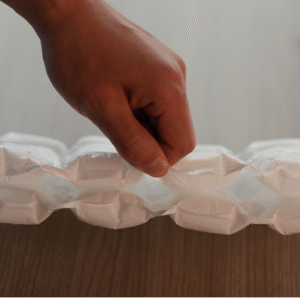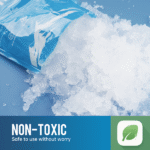Paket gel vs es kering: Solusi rantai dingin mana yang terbaik untuk pengiriman Anda?
Saat mengirimkan produk yang peka terhadap suhu, the choice of cooling solution—Paket gel atau es kering—can significantly impact your shipment’s safety, biaya, dan kinerja. This article breaks down the key differences between these two options, helping you decide which one is ideal for your cold chain needs in 2025.
-
Itu kontrol suhu capabilities of gel packs and dry ice
-
Cost considerations for both options, including reusability and environmental impact
-
Itu safety concerns associated with each solution
-
The best scenarios for using gel packs and dry ice in cold chain shipping
Apa yang Gel Packs and Dry Ice?
Paket gel: An Overview
Paket gel are flexible, reusable cooling solutions that contain a non-toxic gel inside a plastic casing. They work by maintaining a moderate temperature, biasanya antara 32°F and 50°F (0° C hingga 10 ° C.), making them suitable for chilled products seperti makanan, kosmetik, and pharmaceuticals that require refrigeration but not freezing.
Es kering: An Overview
Es kering, made from frozen carbon dioxide (CO2), sublimates at -109.3° f (-78.5° C.), membuatnya ideal untuk produk beku like meat, hidangan laut, dan sampel biologis. It’s the go-to option when products require extreme low temperatures for long durations.
How Do Gel Packs and Dry Ice Compare?
Kisaran suhu: Which Keeps Your Products Cooler?
-
Es kering: Ideal for freezing temperatures, keeping items at sub-zero level.
-
Paket gel: Best for moderate cooling, typically maintaining temperatures between 32°F and 50°F (0° C hingga 10 ° C.).
Lamanya: How Long Do They Last?
-
Es kering: Sublimates over time, generally offering shorter cooling duration unless packed efficiently.
-
Paket gel: Berikan lebih lama, slower cooling but cannot reach the extreme temperatures that dry ice offers.
Safety and Handling: Which Is Safer for Your Team?
-
Paket gel: Safe to touch and handle, with no special equipment needed.
-
Es kering: Requires gloves and proper ventilation due to its extreme cold and the potential for CO2 build-up, which can be hazardous in enclosed spaces.
Perbandingan Biaya: Which Is More Budget-Friendly?
| Solusi Pendinginan | Upfront Cost | Reusability | Shipping Cost | Overall Cost-Efficiency |
|---|---|---|---|---|
| Paket gel | Lebih rendah | Dapat digunakan kembali | Lebih rendah | Cost-effective for short-term shipments |
| Es kering | Lebih tinggi | Sekali pakai | Lebih tinggi | Expensive for long-term shipments |
-
Paket gel are a more cost-effective solution for businesses looking for short-term cooling without the need for ultra-low temperatures.
-
Es kering is typically more expensive upfront and is a one-time-use product, making it more suitable for shipments requiring ultra-low temperatures for long periods.
Masalah keamanan: Which Is Safer to Handle?
-
Paket gel: Safer for handling, with no toxic emissions or extreme cold risks. They can be safely touched and reused.
-
Es kering: Membutuhkan penanganan khusus. Radang dingin can occur upon direct contact, and dry ice can displace oxygen in confined spaces, potentially causing suffocation.
When Should You Use Gel Packs?
Paket gel are perfect for:
-
Short-term shipments where temperature control isn’t critical
-
Products that need Pendinginan sedang (MISALNYA., non-perishable food, kosmetik, Farmasi)
When Is Dry Ice the Best Option?
Es kering is essential when:
-
Pengiriman makanan beku seperti daging, hidangan laut, atau es krim
-
Penanganan Sampel biologis atau Farmasi that require extreme low temperatures
-
Transporting goods over longer distances or extended shipping durations
Emerging Trends in Cold Chain Shipping: What to Expect in 2025
Saat industri rantai dingin berkembang, several inovasi are improving the efficiency and sustainability of cooling solutions:
-
Alternatif berkelanjutan: Eco-friendly gel packs and biodegradable packaging are gaining popularity.
-
Advanced monitoring technologies: Real-time temperature monitoring systems powered by IoT ensure better tracking and compliance.
-
Bahan perubahan fase (PCMS): These materials offer consistent temperature control untuk periode yang lebih lama, becoming a viable alternative to both gel packs and dry ice.
Pertanyaan yang sering diajukan
Q1: Which solution lasts longer—gel packs or dry ice?
-
Dry ice tends to last longer, especially for ultra-low temperatures, while gel packs are more effective for Pendinginan sedang over a longer period.
Q2: Are gel packs safe for food shipments?
-
Ya, gel packs are safe for shipping food, especially non-perishable items that need to stay cool, tapi tidak beku.
Q3: Can I use dry ice for chilled items?
-
Dry ice is not recommended for chilled items as it provides Dingin ekstrem. Gel packs are more suitable for keeping items cool without freezing them.
Kesimpulan dan Rekomendasi
Memilih antara Paket gel Dan es kering depends on the temperature needs of your shipment. Paket gel are perfect for moderate cooling and are more hemat biaya for short-term shipments. Namun, es kering is necessary for shipments requiring ultra-low temperatures and longer durations. By assessing your product type and shipping conditions, you can make an informed decision.
Actionable Tip: If your business is new to cold chain logistics, start with gel packs for non-frozen products and experiment with dry ice for those requiring extreme cold.
Tentang tempk
Pada Tempk, we specialize in providing innovative cold chain solutions for all your shipping needs. Produk kami, including gel packs and dry ice, are designed to maintain the integrity of your products selama transit. We prioritize Keberlanjutan Dan efisiensi biaya in all our solutions.
For expert advice, reach out to us today!
























